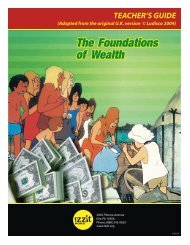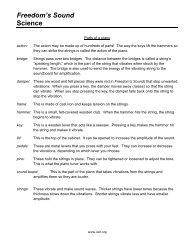Transcript - Izzit.org
Transcript - Izzit.org
Transcript - Izzit.org
You also want an ePaper? Increase the reach of your titles
YUMPU automatically turns print PDFs into web optimized ePapers that Google loves.
plentiful. These are expensive and difficult to produce and distribute, but those are cheap and easy. And<br />
we saw how high prices ration scarce goods, while low prices clear plentiful goods.<br />
MAN: But the market place is simultaneously sending messages back to the producer about the present<br />
state of demand. A busy stall tells the producer people want more of these than they can get. On the<br />
other hand, a slack period in the market tells him people don’t want these very much, with the result that<br />
high prices stimulate increased production, and low prices cause reduced production.<br />
WOMAN: So, price is always acting to encourage producers to produce the right balance of what<br />
customers want to consume, and to keep adjusting to every change in supply and every change in demand.<br />
It happens everywhere. Behind every price in a store there is a volume of information, experience,<br />
calculation and judgment. The manufacturer has worked out his production costs, estimated how many he<br />
could sell at various prices, and picked the price that gives him the biggest profit.<br />
MAN: But he’s competing with all the other manufacturers, and if his sales volume starts to drop, the<br />
message will get back to him fast. If it’s a big change- it may mean a big rethink, and a big change in the<br />
price.<br />
WOMAN: It might even put him out of business. A lot of manufacturers of hand-wound watches had to<br />
do big rethinks when electronic watches came onto the market at a fraction of the price.<br />
MAN: But it also works the other way. In the 1970s, during the UK bread strike, bread prices shot up.<br />
But people still wanted to buy bread. This stimulated others to hire trucks and import loaves from<br />
Holland. At the normal price, transport costs were too high to make bread importing worth anyone’s<br />
while. But when scarcity doubled the price, it was a very different story.<br />
WOMAN: In the same way, the quadrupling of world oil prices in 1974 made other kinds of energy<br />
production more attractive to producers. Offshore oil, coal, nuclear power, wind power, they all had been<br />
rated too expensive, but that only meant compared with oil. So, when oil prices shot up, it became worth<br />
people’s while to pay the extra production and distribution costs, because they could now charge pricesthey<br />
never could have charged when oil was cheap.<br />
MAN: The high oil price did what high prices always do-- discouraged and rationed the consumer, but<br />
encouraged and stimulated the producer.<br />
WOMAN: What happens is this: When the price is high, people are encouraged to produce a lot.<br />
MAN: But after the first rush, you won’t get many customers, because the high price puts them off.<br />
You’ll have a lot of unsold goods. As the price drops, fewer people think it’s worth producing. But more<br />
people think it’s worth buying, and so it goes on.<br />
WOMAN: About here, you reach a point of balance, a price which stimulates the production of just<br />
about the amount that customers will buy at that price. If the price goes on downwards, more and more<br />
producers will be discouraged, but at each falling price stage- more and more people will want the goods.<br />
MAN: That’s when you get fights, queues and black markets. This price, the one in the middle, is called<br />
the equilibrium price, the price most goods settle down at.<br />
WOMAN: So, just as we saw in the last program that there’s a law of demand. There’s an equally<br />
important law of supply…it’s this:<br />
42

















